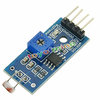I have a little ornament on my guitar that I would likem to light up with 6 LEDS. I'd like for them to automatically liight, when it is dark.
I have photo resistors with the specs listed below, but I am understanding that they would have the opposite effect- ie: turn the lights on when it is not dark. How could I make them go on when it is dark?
Thnak-you
5mm GM5539 Photoresistor:
Maximum voltage: 150 Volt DC
Spectral peak: 540 nm
Maximum wattage: 100 mW
Light resistance (10 Lux): 50-100 Kohm
Operating temperature: - 30 ~ + 70 degree Celsius;
I have photo resistors with the specs listed below, but I am understanding that they would have the opposite effect- ie: turn the lights on when it is not dark. How could I make them go on when it is dark?
Thnak-you
5mm GM5539 Photoresistor:
Maximum voltage: 150 Volt DC
Spectral peak: 540 nm
Maximum wattage: 100 mW
Light resistance (10 Lux): 50-100 Kohm
Operating temperature: - 30 ~ + 70 degree Celsius;




